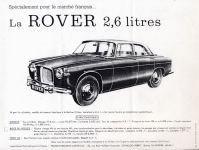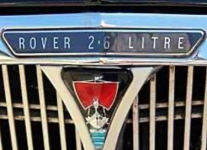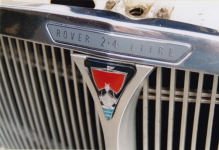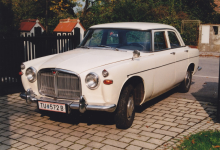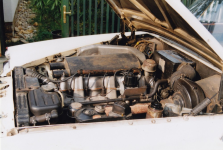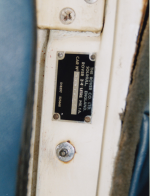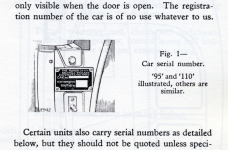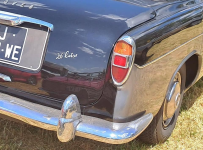This article is reposted from James Taylor's Facebook feed. He originally covered this topic in his excellent P5 book, which is highly recommended for anyone interested in Rovers or British cars. https://www.facebook.com/james.t.roverphile
One of the things I have always found interesting about both Rover cars and Land Rovers is the variety of special versions that were built for different markets around the world. As often as not, these special versions were never seen in the UK (at least, not outside of the factory grounds), and that makes them doubly interesting.
In the first half of the 1960s, Rover aimed for stronger European sales with smaller-engined variants of the P5 saloon that got around tax barriers. These cars were always rare, and are even rarer today. A recent post on British Leyland Chronicles prompted me to bring forward this story that I put together some time ago.
If you enjoy reading this story, please hit the “Like” button because this helps me to judge how popular one subject is against another. As always, if you want to share it or copy it, please feel free to do so – but don’t forget to acknowledge where you found it.
TAX-BREAK SPECIALS
Rover had accepted the need to make minor modifications to its cars and Land Rovers for overseas markets during the 1950s, typically providing different lighting arrangements to meet local regulations. But it would be the 1960s before they created special models for overseas.
It seems to have been William Martin-Hurst who initiated a new approach after he joined Rover in 1960, progressing from Production Director to Deputy Managing Director and then in 1962 to Managing Director. He was the one who agreed to make special models of the P5 for some countries on the European continent; he was the one who was prepared to fit special engines into Land Rovers for the USA to help sales there (and that was how the V8 started out); and he was the one who agreed to using the high-power Weslake-head engine in North American Land Rovers instead of the low-compression engine that every other country got.
The first of those initiatives must have got under way in 1961, as the first examples of the special-engined P5 saloons were built in 1962. There were two types, one with a 2.6-litre engine and the other with a 2.4-litre engine. Both were intended as ways of getting around the high rates of taxation that some countries imposed on big-engined cars like the standard 3-litre P5. Neither was very successful, and there were just 156 examples of these “small-engined” P5 models in four seasons of production.
The 2.6-litre P5, 1962-1965
In France, any engine larger than 2.7 litres was subject to a high rate of taxation, which made the P5 3-litre virtually unsaleable. However, there was a ready-made solution to hand in the short-stroke 2.6-litre version of the 3-litre engine that was in production for the P4 100 models.
A more powerful 123bhp “Weslake head” version of this engine was in the works for 1962, when it would be fitted to the 110, and Rover decided to use this in the new 2.6-litre P5. Special gearbox ratios may have compensated for the lower torque figure, and the gearboxes certainly had their own 725-prefix numbers. Just one RHD Rover 2.6-litre was built, and became the test and development car at Solihull. Production of the LHD models then started in April 1962 with a batch of 24, so making that year’s total production up to 25. Even though these were technically MkIA models, they anticipated the 1963 Mk IIA 3-litre specification in two respects: they were the first P5s with Weslake-head engines, and they were the first to have the new style of grille badge with its light grey enamel background. In their case, it read, “Rover 2.6-litre”. All of them had manual gearboxes (although whether with overdrive or not is unclear), and all the LHD cars were delivered to Rover’s French importers, Franco-Britannic Autos in Paris.
Sales must have been strong enough to persuade Rover that it was worth continuing production of the 2.6-litre car into the Mk II era. A further 92 examples with left-hand-drive were built for the French market over the next three seasons, but sales showed a fairly steep decline from the high of 43 in the 1963 model-year. Once again, they had special gearboxes, this time with a 780 prefix. Clearly seeking further sales outlets, Rover secured an order for the 2.6 from Nigeria, and 13 RHD cars were built to suit, while a fourteenth went to Franco-Britannic in Paris, possibly for a Nigerian diplomat stationed there.
Bizarrely, the Rover Despatch Department recorded all these Mk II 2.6-litre cars as Coupés, although they were in fact Saloons. Even Franco-Britannic got it wrong, and their sales brochure for the 2.6-litre pictured a Coupé! It can hardly have helped sales…
The 2.4-litre P5, 1962
Austria had a similar aversion to large-engined cars, and this time the barrier was set at 2.5 litres. Clearly, the 2.6-litre engine would not do, and so Rover developed a special 2.4-litre version of their seven-bearing “six” purely for this market. Engine designer Jack Swaine remembered William Martin-Hurst asking him to develop this, and the engines team came up with a new short-stroke crankshaft that gave a displacement of 2490cc.
Like the 2.6-litre engine in the French-market P5s, the 2.4-litre had the latest Weslake head to maximise power and torque. Factory figures are not available, but a registration document for one of the surviving cars quotes the power output as 111PS (roughly 109bhp) at 5000rpm. The gearbox was the same 725-prefix type as in the contemporary 2.6-litre models.
The Austrian-market Rover 2.4-litre entered production in July 1962, just a week before assembly of the last 1962-model Mk IA 2.6-litres ended, and was generally to Mk IA specification. An initial batch of 25 cars was built between then and the end of August, but there would be no more. All of them were delivered to Rover’s Austrian importers, OJ Aulehla in Vienna, but sales were slow – one of three known survivors was not registered until March 1963. Perhaps performance was poor: the P5 was, after all, a heavy car, and the torque of the short-stroke engine must have been barely enough to deliver respectable acceleration, even with the manual gearbox that was standard. By 1964, OJ Aulehla had lost the Rover franchise and Austrian sales were being handled by the Carl Jeschek company in Vienna. Perhaps that tells its own story.
Provisional plans had been made for a Mk II Rover 2.4-litre, but it seems certain that none were built. It does look as if chassis plates for them had been made up, though, because one was illustrated by mistake in the January 1963 edition of Rover’s Workshop Manual for the P4 range: the illustrator must have been given the wrong plate to copy for his picture of a 110 chassis plate, and the picture clearly shows a plate reading “Rover 2.4-litre Mk II”!
Our knowledge of these sideshows to the P5 story is pitifully small, and few Rover enthusiasts know that the cars ever existed. It is quite likely that some of those who know of survivors do not realise how rare they are, so it would be nice if this short article were to bring new information out of the woodwork, especially from readers in Europe. Please remember that any information, however trivial it may appear, could add more to the story. Although a type-written parts list for the 2.4-litre and 2.6-litre cars survives (dated February 1965), no service manuals, magazine road-tests or advertisements have ever been found – but surely there must have been some!
Just in case it helps in the identification of one of these rare cars, the chassis number prefix of all the 2.4-litre models was 788. The Mk IA 2.6-litres were 756 (RHD) and 758 (LHD), and the Mk IIA types were 781 (RHD) and 783 (LHD).
(Special thanks to the Mayr-Harting family for the pictures of the 2.4, which was once owned by Herr Aulehla of the Austrian importers.)
The first picture shows the 2.6-litre Weslake-head engine, but it's in a P4 110, not a P5. There are more pictures in the Comments.
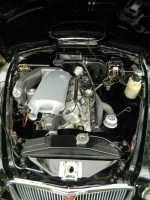
One of the things I have always found interesting about both Rover cars and Land Rovers is the variety of special versions that were built for different markets around the world. As often as not, these special versions were never seen in the UK (at least, not outside of the factory grounds), and that makes them doubly interesting.
In the first half of the 1960s, Rover aimed for stronger European sales with smaller-engined variants of the P5 saloon that got around tax barriers. These cars were always rare, and are even rarer today. A recent post on British Leyland Chronicles prompted me to bring forward this story that I put together some time ago.
If you enjoy reading this story, please hit the “Like” button because this helps me to judge how popular one subject is against another. As always, if you want to share it or copy it, please feel free to do so – but don’t forget to acknowledge where you found it.
TAX-BREAK SPECIALS
Rover had accepted the need to make minor modifications to its cars and Land Rovers for overseas markets during the 1950s, typically providing different lighting arrangements to meet local regulations. But it would be the 1960s before they created special models for overseas.
It seems to have been William Martin-Hurst who initiated a new approach after he joined Rover in 1960, progressing from Production Director to Deputy Managing Director and then in 1962 to Managing Director. He was the one who agreed to make special models of the P5 for some countries on the European continent; he was the one who was prepared to fit special engines into Land Rovers for the USA to help sales there (and that was how the V8 started out); and he was the one who agreed to using the high-power Weslake-head engine in North American Land Rovers instead of the low-compression engine that every other country got.
The first of those initiatives must have got under way in 1961, as the first examples of the special-engined P5 saloons were built in 1962. There were two types, one with a 2.6-litre engine and the other with a 2.4-litre engine. Both were intended as ways of getting around the high rates of taxation that some countries imposed on big-engined cars like the standard 3-litre P5. Neither was very successful, and there were just 156 examples of these “small-engined” P5 models in four seasons of production.
The 2.6-litre P5, 1962-1965
In France, any engine larger than 2.7 litres was subject to a high rate of taxation, which made the P5 3-litre virtually unsaleable. However, there was a ready-made solution to hand in the short-stroke 2.6-litre version of the 3-litre engine that was in production for the P4 100 models.
A more powerful 123bhp “Weslake head” version of this engine was in the works for 1962, when it would be fitted to the 110, and Rover decided to use this in the new 2.6-litre P5. Special gearbox ratios may have compensated for the lower torque figure, and the gearboxes certainly had their own 725-prefix numbers. Just one RHD Rover 2.6-litre was built, and became the test and development car at Solihull. Production of the LHD models then started in April 1962 with a batch of 24, so making that year’s total production up to 25. Even though these were technically MkIA models, they anticipated the 1963 Mk IIA 3-litre specification in two respects: they were the first P5s with Weslake-head engines, and they were the first to have the new style of grille badge with its light grey enamel background. In their case, it read, “Rover 2.6-litre”. All of them had manual gearboxes (although whether with overdrive or not is unclear), and all the LHD cars were delivered to Rover’s French importers, Franco-Britannic Autos in Paris.
Sales must have been strong enough to persuade Rover that it was worth continuing production of the 2.6-litre car into the Mk II era. A further 92 examples with left-hand-drive were built for the French market over the next three seasons, but sales showed a fairly steep decline from the high of 43 in the 1963 model-year. Once again, they had special gearboxes, this time with a 780 prefix. Clearly seeking further sales outlets, Rover secured an order for the 2.6 from Nigeria, and 13 RHD cars were built to suit, while a fourteenth went to Franco-Britannic in Paris, possibly for a Nigerian diplomat stationed there.
Bizarrely, the Rover Despatch Department recorded all these Mk II 2.6-litre cars as Coupés, although they were in fact Saloons. Even Franco-Britannic got it wrong, and their sales brochure for the 2.6-litre pictured a Coupé! It can hardly have helped sales…
The 2.4-litre P5, 1962
Austria had a similar aversion to large-engined cars, and this time the barrier was set at 2.5 litres. Clearly, the 2.6-litre engine would not do, and so Rover developed a special 2.4-litre version of their seven-bearing “six” purely for this market. Engine designer Jack Swaine remembered William Martin-Hurst asking him to develop this, and the engines team came up with a new short-stroke crankshaft that gave a displacement of 2490cc.
Like the 2.6-litre engine in the French-market P5s, the 2.4-litre had the latest Weslake head to maximise power and torque. Factory figures are not available, but a registration document for one of the surviving cars quotes the power output as 111PS (roughly 109bhp) at 5000rpm. The gearbox was the same 725-prefix type as in the contemporary 2.6-litre models.
The Austrian-market Rover 2.4-litre entered production in July 1962, just a week before assembly of the last 1962-model Mk IA 2.6-litres ended, and was generally to Mk IA specification. An initial batch of 25 cars was built between then and the end of August, but there would be no more. All of them were delivered to Rover’s Austrian importers, OJ Aulehla in Vienna, but sales were slow – one of three known survivors was not registered until March 1963. Perhaps performance was poor: the P5 was, after all, a heavy car, and the torque of the short-stroke engine must have been barely enough to deliver respectable acceleration, even with the manual gearbox that was standard. By 1964, OJ Aulehla had lost the Rover franchise and Austrian sales were being handled by the Carl Jeschek company in Vienna. Perhaps that tells its own story.
Provisional plans had been made for a Mk II Rover 2.4-litre, but it seems certain that none were built. It does look as if chassis plates for them had been made up, though, because one was illustrated by mistake in the January 1963 edition of Rover’s Workshop Manual for the P4 range: the illustrator must have been given the wrong plate to copy for his picture of a 110 chassis plate, and the picture clearly shows a plate reading “Rover 2.4-litre Mk II”!
Our knowledge of these sideshows to the P5 story is pitifully small, and few Rover enthusiasts know that the cars ever existed. It is quite likely that some of those who know of survivors do not realise how rare they are, so it would be nice if this short article were to bring new information out of the woodwork, especially from readers in Europe. Please remember that any information, however trivial it may appear, could add more to the story. Although a type-written parts list for the 2.4-litre and 2.6-litre cars survives (dated February 1965), no service manuals, magazine road-tests or advertisements have ever been found – but surely there must have been some!
Just in case it helps in the identification of one of these rare cars, the chassis number prefix of all the 2.4-litre models was 788. The Mk IA 2.6-litres were 756 (RHD) and 758 (LHD), and the Mk IIA types were 781 (RHD) and 783 (LHD).
(Special thanks to the Mayr-Harting family for the pictures of the 2.4, which was once owned by Herr Aulehla of the Austrian importers.)
The first picture shows the 2.6-litre Weslake-head engine, but it's in a P4 110, not a P5. There are more pictures in the Comments.


